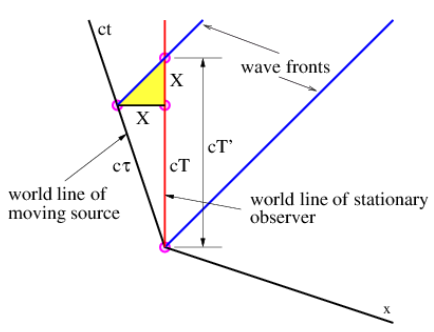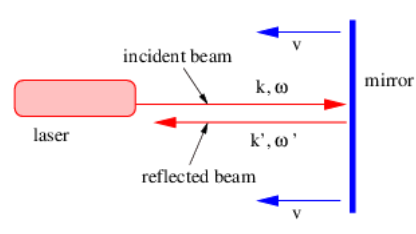5.7: Problems
( \newcommand{\kernel}{\mathrm{null}\,}\)

- Sketch the wave fronts and the k four-vector in a spacetime diagram for the case where ω/k=2c. Label your axes and space the wave fronts correctly for the case k=4п m−1.
- If the four-vector k=(0,1nm−1) in the rest frame, find the space and time components of k in a frame moving to the left at speed c/2.
- Let’s examine the four-vector u_=(u9,c)(1−β2)1/2 where β=ug/c,ug being the velocity of some object. The four-vector u is called the four-velocity.
- Show that u is parallel to the world line of the object.
- Show that u⋅u=−c2.
- If ug is the group velocity of a relativistic wave packet, show that k=(μ/c2)u, where k is the central wave four-vector of the wave packet.
- Find the Doppler shift for a moving source of light from Figure 5.7.5:, roughly following the procedure used in the text to find the shift for a moving observer. (Assume that the source moves to the left at speed U.) Is the result the same as for the moving observer, as demanded by the principle of relativity?
- Find the Doppler shift for a stationary source of sound ( c≈380 m s−1 in a stationary atmosphere) as measured by a moving observer. Follow the procedure as for light in section 5.5 except note that the proper time τ is virtually the same as the time T′ in Figure 5.7.3: since speeds are much less than the speed of light.
- Suppose you shine a laser with frequency ω and wavenumber k on a mirror moving toward you at speed v, as seen in Figure 5.7.6:. What are the frequency ω′ and wavenumber k′ of the reflected beam? Hint: Find the frequency of the incident beam in the reference frame of the mirror. The frequency of the reflected beam will be the same as that of the incident beam in this frame. Then transform back to the reference frame of the laser.
 Figure 5.7.6:: Laser beam reflecting off of a moving mirror.
Figure 5.7.6:: Laser beam reflecting off of a moving mirror.
- Suppose you shine a laser with frequency ω and wavenumber k on a mirror moving toward you at speed v, as seen in Figure 5.7.6:. What are the frequency ω′ and wavenumber k′ of the reflected beam? Hint: Find the frequency of the incident beam in the reference frame of the mirror. The frequency of the reflected beam will be the same as that of the incident beam in this frame. Then transform back to the reference frame of the laser.
- Suppose the moving twin in the twin paradox has a powerful telescope so that she can watch her twin brother back on earth during the entire trip. Describe how the earthbound twin appears to age to the travelling twin compared to her own rate of aging. Use a spacetime diagram to illustrate your argument and consider separately the outbound and return legs. Remember that light travels at the speed of light! Hint: Does the concept of Doppler shift help here?
- Find the velocity of an object with respect to the rest frame if it is moving at a velocity of 0.1c with respect to another frame which itself is moving in the same direction at 0.1c relative to the rest frame using
- the Galilean formula and
- the formula of special relativity. Determine the fractional error made in using the Galilean formula.
- Each stage of a high performance 3 stage rocket can accelerate to a speed of 0.9c from rest. If the rocket starts from rest, how fast does the final stage eventually go?
- the Galilean formula and
- the formula of special relativity. Determine the fractional error made in using the Galilean formula.
- An interstellar spaceship is going from Earth to Sirius with speed U = 0.8c relative to the rest frame. It passes a spaceship which is going from Sirius to Earth at a speed of 0.95c in the reference frame of the first spaceship. What is the velocity (direction and speed) of the second spaceship in the rest frame?
- An interstellar spaceship is going from Earth to Sirius with speed U = 0.8c relative to the rest frame. It passes a spaceship which is going from Sirius to Earth at a speed of 0.95c in the reference frame of the first spaceship. What is the velocity (direction and speed) of the second spaceship in the rest frame?

